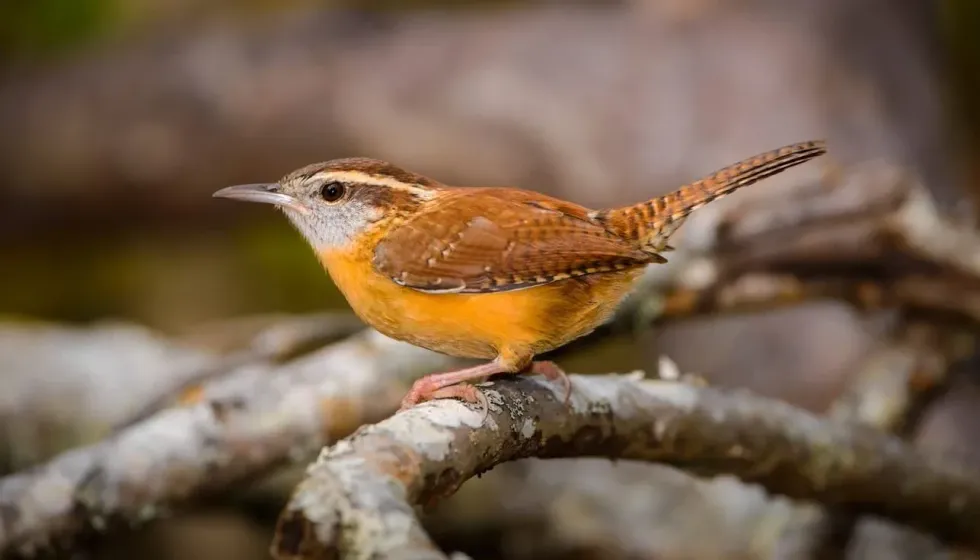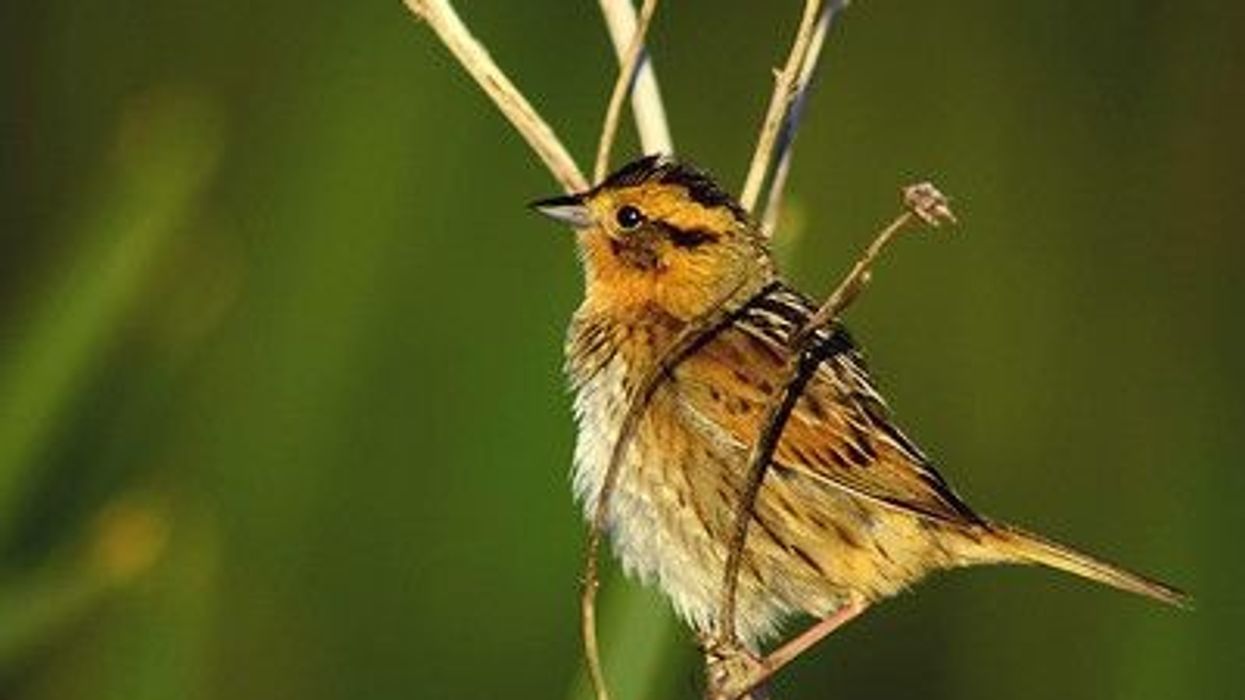The Carolina wren, Thryothorus ludovicianus, is a beautiful North American songbird found abundantly in the southeastern United States. These birds can also be seen in north-eastern Mexico, Yucatan Peninsula, Honduras, and Nicaragua.
The largest wren species found in eastern America, these birds are commonly found in dense vegetation like bottomland woods and suburban areas with thick vines and bushes.
Smaller than sparrows in size, these wrens are covered in reddish brown and orange plumage with white eyebrows and a long curved bill. The bird builds its nest in different places ranging from tree hollows and crevices to garages, mailboxes, old hornet nests, old cans, and even used boots.
The Carolina wren nest is made with twigs, dry leaves, and sticks which both parents collect from the surrounding area. The Carolina wren call is one of the most melodious tunes.
The songs are sung by this monogamous pair to make their presence felt and to defend their territory.
In recent years, the birds are seen venturing farther north in the colder climate. This could be attributed to the warmer climatic conditions owing to climate change.
Read on to learn more about this beautiful wren, and if you like this article, then check out these Wren Facts and House Wren Facts.
Carolina Wren Interesting Facts
What type of animal is a Carolina wren?
The Carolina wren is a small colorful North American bird of the Troglodytidae family.
What class of animal does a Carolina wren belong to?
Carolina wrens belong to the class Aves of the animal kingdom.
How many Carolina wrens are there in the world?
According to an independent study conducted by the American Bird Conservancy, there are approximately 18 million of these birds currently living on this planet.
Where does a Carolina wren live?
The Carolina wren bird is mostly found in the southeastern United States and some parts of Canada. These are averse to extremely cold climates and fly back south from northern parts in winter.
What is a Carolina wren's habitat?
Carolina wrens are commonly spotted in different places. These small colorful birds can build their nests anywhere. They build their nests in the dense vegetation of forests and neighborhoods. The bird is also spotted making its way through the dense undergrowth and tangles in backyards and areas thickly filled with vines and bushes.
Who does Carolina Wrens live with?
Carolina wrens are seen in pairs of male and female, throughout the year. They live with their partners and defend their territories. The males of this wren species sing beautiful melodies and females often accompany them.
How long does a Carolina wren live?
Not much research is available regarding how long these wrens can survive in the wild. However, in Florida, one Carolina wren was recaptured and released during banding operations, in the year 2004. That particular wren was seven years and eight months old at that time.
How do they reproduce?
The Carolina wren reproduces like most birds. These monogamous birds brood twice to thrice a year and lay eggs in batches of 4-8 in these nests which range from 3-9 in (7-22 cm), in length and 3-6 in 7-15 cm), in breadth.
Carolina wren eggs are white with brown blotches and hatch after an incubation period of 12-16 days. Baby wrens mature and leave their nest after 12-14 days. The female Carolina wrens take part in incubation while both parents bring food for the chicks in the initial days.
What is their conservation status?
The Carolina Wren is classified as species of Least Concern by the International Union for Conservation of Nature or the IUCN Red List.
Carolina Wren Fun Facts
What do Carolina wrens look like?

Carolina wren, Thryothorus ludovicianus, is a brightly colored bird as compared to most other wrens. These tiny birds are smaller than sparrows and are shy birds whose rich melodies can be heard from every nook and corner of trees, in summer.
Their rich cinnamon plumage combined with a unique white eyebrow stripe and upward-cocked tail is hard to miss. These chunky wrens have a small round body with a large head and little neck.
Both sexes of this species have bright reddish brown feathers on the top and warm orange feathers on the underside. The chin and throat of these birds are covered in white feathers and they have a dark, slender, and long down-curved bill.
How cute are they?
These beautiful birds are a treat to the eyes and their cuteness mainly stems from their reddish brown and orange bodies and tiny size.
How do they communicate?
The Carolina Wren song is quite popular and can be heard coming from the trees of almost every densely populated forest in the summertime. Although, unlike other wren species, males are responsible for singing beautiful melodies, females often offer their chattering notes to these songs.
The pairs can be seen singing and defending their territory all year long. They defend their territories by their loud call which keeps other birds away.
How big is a Carolina wren?
Carolina wrens are 4.7-5.5 in (12-14 cm) in length.
These wrens are almost twice the size of the bee hummingbird, the smallest bird species in the world which is about 2.25 in (5.71 cm).
How fast can a Carolina wren fly?
Carolina wrens are not adept at flying. This weak flyer species makes brief aerial journeys across short distances mostly to look for food and find materials to build their nests.
How much does a Carolina wren weigh?
A Carolina wren weighs about 0.6-0.8 oz (18-22 g).
What are the male and female names of the species?
Male and female Carolina wrens do not have distinct names. However, in most birds, males are referred to as cocks, and females are called hens.
What would you call a baby Carolina wren?
A baby Carolina wren is called a chick.
What do they eat?
The Carolina wren is an omnivorous bird. Their food habits include insects like caterpillars, beetles, grasshoppers, stick bugs, spiders, and snails to name a few. Wrens also feed on small lizards and tree frogs. In winter, the bird also eats berries, small fruits, poison ivy, and some fruit pulp.
Are they dangerous?
The Carolina wren is not known to be a dangerous bird. They only vigorously defend their territories with their partners.
Would they make a good pet?
These tiny birds would make for very cute pets. Males sing a melodious tune and they are fascinating to look at.
Did you know...
One reason why these birds build multiple nests is to confuse their predators which attack the young ones when the parents are away.
The Carolina wren's nest
This bird builds its nest in open cavities like tree hollows, overhangs, and crevices which are about 3-6 ft (0.9-1.8 m) above the ground. Apart from these usual nesting sites, they also build their nests in discarded mailboxes, garages, old hornet nests, tin cases, old boots, and sometimes even in a nest box.
The males and females build the nests together in different places before they finally settle for one location. While the first nest takes some time to build, the next nests are built within a week.
Wrens use plant matter like dried leaves, twigs, and straws to build cup-shaped domed nests to lay their eggs.
During the incubation period, females sometimes line the inner side of the nest with snakeskin. The nests are generally 3-9 in, in length and 3-6 in, in breadth.
The Carolina wren's call
Unlike other wren species, only males sing the rich tunes with notes that often sound like 'tea-kettle-tea-kettle'. Females accompany them and often add their chattering notes to the melody.
Their songs are used to mark their territory, making other birds aware of their presence in that region. Both sexes can give out loud alarm calls when they feel a threat approaching.
Here at Kidadl, we have carefully created lots of interesting family-friendly animal facts for everyone to discover! For more relatable content, check out these Florida Grasshopper Sparrow Facts and Common Grackle Facts.
You can even occupy yourself at home by drawing one on our Carolina Wren coloring pages.










